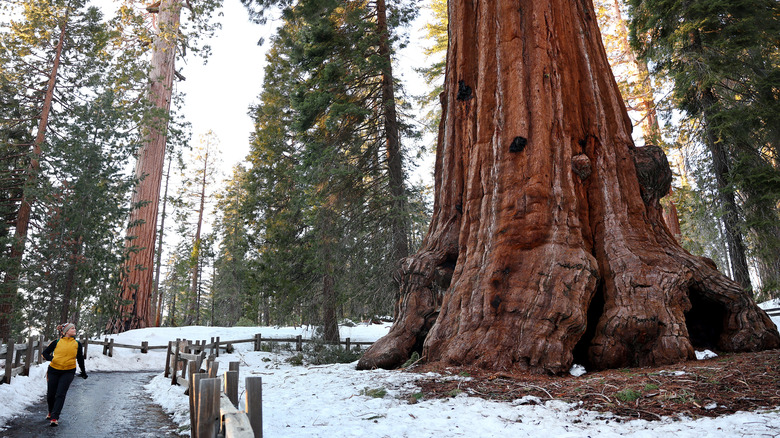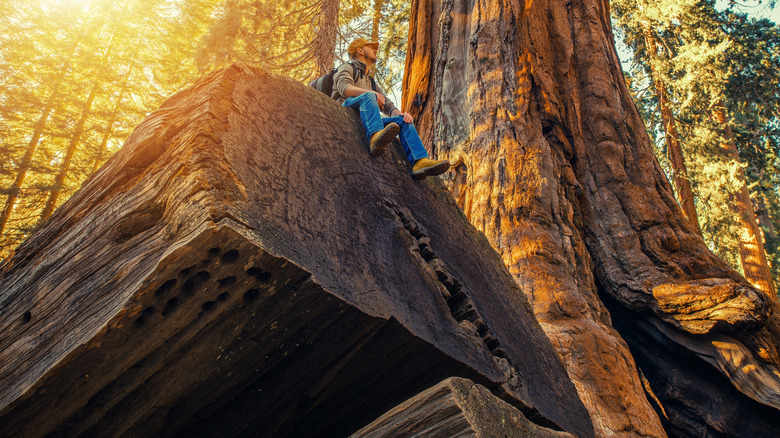Travel Guides Outdoor Adventures
Joshua St. James
When the subject of enormous trees comes up, the Giant Sequoias of California’s Sequoia National Park are sure to be a topic of conversation. However, because California is home to more National Parks than any other state, an unsuspecting neighbor also holds the title for some of the world’s largest trees, including the second largest tree, the General Grant Tree. Kings Canyon National Park borders the Sequoia National Park, nestled in California’s Sierra Nevada Mountains. Though both parks are known for the world’s largest trees, the General Sherman Kings Canyon holds the second largest tree on Earth entirely within its borders.
Comprised of two distinct sections, Grant Grove and Cedar Grove, the park invites visitors to experience some of the world’s most ancient trees. The General Grant Tree is located in the Grant Grove section of Kings Canyon National Park and stands at a height of approximately 268 feet and a base circumference of over 107 feet! Kings Canyon National Park encompasses more than 461,901 acres of land, a massive 722 square miles, but there’s more than just the enormous amount of acreage to explore.
The park features a deeper canyon than the infamous Grand Canyon, with a maximum height of 8,200 feet from the canyon floor to the top. Carved by the powerful erosive forces of glaciers over 10 million years ago, this immense canyon is often called “a rival to Yosemite.” While it may not be as famous as its counterpart, Kings Canyon boasts its own unique charm and stunning vistas.
The towering giant sequoias of Kings Canyon

Mario Tama/Getty Images
Kings Canyon National Park is known for its awe-inspiring natural wonder, giant sequoias. These massive trees, also called Sequoiadendron giganteum, are native only to a limited 75 groves west of the Sierra Nevadas in the United States. Walking among these colossal giants, visitors can’t help but feel a sense of reverence and wonder. Known for living over 3,000 years, and with one verified at 3,210 years old, many of the park’s most iconic giant sequoia are officially some of the oldest living organisms on Earth.
Kings Canyon National Park contains four of the largest 30 giant sequoias on Earth, while its neighboring park, the Sequoia National Park, contains an additional 14. In addition to their record-breaking size, giant sequoias are distinctly cone-shaped with reddish-brown bark and dense foliage. They typically reach a diameter of over 20 feet and can grow up to 300 feet tall.
While giant sequoias steal the spotlight, Kings Canyon National Park boasts a remarkable diversity of tree species. From ponderosa pines to sugar pines and incense cedars to white firs, the park’s forested areas create a tapestry of colors and textures. The coniferous forest of Kings Canyon National Park is truly unique and offers visitors a chance to explore an ecosystem filled with giants.
The impact of fire and climate change on the giants of Kings Canyon

Welcomia/Getty Images
Giant sequoias are remarkably resilient and can survive many fires due to their thick bark. Fire actually plays a vital role in the life cycle of these trees as it helps open their cones and release seeds that can take root on the cleared forest floor. However, climate change has led to longer and more intense droughts in Kings Canyon National Park, increasing the likelihood of catastrophic fires. For example, from 2015 to 2021, over 85% of the giant sequoia groves in the area were burned by destructive fires, according to the National Park Service.
Before visiting the park, visitors should check for fire closures and areas affected by winter storms. As the climate continues to change, it is crucial to take active steps to reduce the risk of fires, such as being aware of prescribed burn locations, minimizing the possibility of human-caused fires, and following all the current fire safety regulations. By adhering to these best practices, visitors can help protect the giant sequoias and the surrounding ecosystem.
The National Park Service also encourages visitors to follow Leave No Trace principles, like staying on marked trails, packing out trash, and respecting wildlife. Visiting the giant sequoias is an incredible experience, but it’s important to be mindful of the environment and show respect for nature. In taking these measures, visitors can help ensure that the giant sequoias of Kings Canyon National Park are able to thrive for generations to come.

